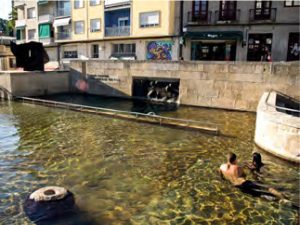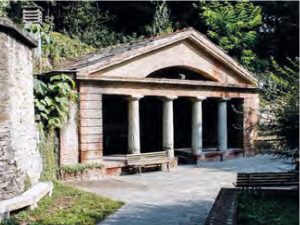Spas in Antiquity
Discover the ancient beginnings of wellbeing

Award-winning and world famous
Discover a phenomenon
Although it is most probably that the use of hot mineral springs for health purposes is as old as humanity itself, History usually marks the beginning of hydrotherapy and thermalism with the Ancient Greece and Roman civilizations.
The abundance of warm and hot springs greatly influenced the life of Ancient Greece. By the 5th century BC this civilization already knew about the healing properties of these waters, and bathing was a widespread therapy, carried out at the first public bathhouses.
While Greeks ritualised the waters as sacred, being the domain of gods and heroes – which would explain its “magical” effects – they also were the first ones to observe and study them from a scientific perspective.
It was here where balneology was born as a science.
The Romans continued many of the Greek bathing practices and expanded them through the continent. While building their Empire, they brought their thermal culture with them, hunting for springs on their way and erecting magnificent buildings to harness them, thermae and balnea which became centres of social life and the best symbol for their urban culture.
Most of the spa towns in Europe have been built upon the remains of these Roman settlements, famous for their healing waters: Vichy (Aquis Calidis), Baden-Baden (Aquae Aureliae), Wiesbaden (Aquae Mattiacorum), Bath (Aquae Sulis), Ourense (Aquis Auriensis), ChavesVerín (Aquae Flaviae), etc.
Cultural Route of the Council of Europe
EHTTA is responsible for managing the European Route of Historic Thermal Towns, a Cultural Route of the Council of Europe since 2010. Launched by the Council of Europe in 1987, “the Cultural Routes demonstrate by means of a journey through space and time how the heritage of the different countries and cultures of Europe contributes to a shared and living cultural heritage”
THERMAL KNOWLEDGE
Roman baths across the Empire varied in size and complexity, but all of them were designed to accommodate the bathing ritual: moving through a number of rooms with increasing temperatures to end with a cold plunge. Most contained an apodyterium, which may refer to a changing room, the frigidarium (cold room), the tepidarium (warm room) and the caldarium (hot room) along with the open pool for swimming, the natation.




Don‘t miss these highlights
Acqui Terme (Italy)
“Aquae Statiellae“ was founded between the 2nd and 1st centuries BC. Today the archeological site of the Roman bath of Corso Bagni is the most impressive thermal site. In the Bagni district, along Bormida river, stands the Roman aqueduct arches. It is the best preserved of all the monuments of this type still in existence in the territory of present-day Piedmont.
Baden-Baden (Germany)
A seventeen-step ritual combining Roman and Irish bathing traditions can be enjoyed today at the Friedrichsbad, built in 1877 on the foundations of a Roman bath.
Bath (UK)
Impressive Roman baths and remains, surrounded by world-famous 18th century architecture has made this spa town a UNESCO World Heritage Site.
Bursa (Turkey)
Roman foundations lie under Bursa’s “Armutlu Hamam” built in the 14th century, when Bursa was the capital of the Ottoman state.
São Pedro do Sul (Portugal)
Extensive ruins of the Roman baths.
Caldes de Montbui (Spain)
Ruins of the 2nd century medicinal thermal bath complex with a large pool made of “opus signium” (made of broken compacted tiles, used in Roman times), covered by a vaulted ceiling.
Chaves-Verín (Portugal/Spain)
The Museum of Roman Baths in Chaves (Eurocity Chaves-Verín) is a museum dedicated to the remains of the largest Roman baths on the Iberian Peninsula.
The 2,000-year-old complex was discovered in 2006 during the construction work for an underground car park.
Excavations have revealed a large main pool, a secondary pool, and a complex system of pipes for transporting the waters and for drainage. Chaves was founded by the Romans as “Aquae Flaviae“ in AD78 and the 140 meter-long Ponte Trajano (Trajan Bridge) dates from the reign of Emperor Trajan in the early second century AD.
Ourense (Spain)
The As Burgas pool in the centre of the town, a sensitive redevelopment of the ancient Roman facilities.
The European Route of Historic Thermal Towns
European Historic Thermal Towns Association (EHTTA)
Member Towns: Acqui Terme | Bad Ems | Bad Homburg | Bad Kissingen | Baden bei Wien | Baden-Baden | Bagnoles de l‘Orne | Bath | Bursa Metropolitan Municipality | Caldas da Rainha | Caldes de Montbui | Castrocare Terme e Terra del Sole | Châtel-Guyon | Daruvar | Enghien-les-Bains | Fiuggi | La Bourboule | Lądek-Zdrój ¸ | Le Mont Dore | Lipik | Loutra Pozar | Loutraki-Perachora | Luchon | Mondariz Balneario | Mondorf-les-Bains | Montecatini Terme | Montegrotto Terme | Ourense | Royat-Chamalières | Salsomaggiore Terme | São Pedro do Sul | Spa | Telese-Terme | Vichy | Varaždinske Toplice | Wiesbaden
International Partner: Poços de Caldas
Associate Members: Governorship of Afyonkarahisar | Budapest Spas cPlc | Chaves-Verin Eurocity | Clermont Auvergne Metropole | Fédération Thermale et Climatique Française (F.T.C.F.) | Galicia Region | Hellenic Association of Municipalities with Thermal Springs (H.A.M.T.S) | Imereti Region | Karlovy Vary Region | Province of Ourense | Route des Villes d‘Eaux du Massif Central
About us:
Europe’s Historic Thermal Towns, all based around healing mineral-water springs, have been centres of health, well-being, culture and tourism for centuries, and their development over the years has led to a rich and varied architectural heritage. Discover the stories, buildings, culture and festivals, and of course the waters themselves in a tour through the European Route of Historic Thermal Towns with its almost 50 towns in 18 countries.
Photo credits: p.1: Wiesbaden Congress & Marketing GmbH, Caldes de Montbui, Bagnoles de l‘Orne | p.2: Caldas da Rainha, Bath – Ioan Said, Afyonkarahisar, p.4: shutterstock.com, Caldas da Rainha | p.5: Afyonkarahisar, shutterstock.com, Vichy
For more information:
![]() european-historic-thermal-towns-association
european-historic-thermal-towns-association
Email: communications@ehtta.eu
Trade and Media contact: Phone: +49 6128 9803481
European Historic Thermal Towns Association (AISBL)
Registered Office: Hôtel de Ville, Rue de l’Hôtel de Ville 44, 4900 Spa (Belgium)

